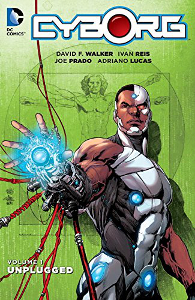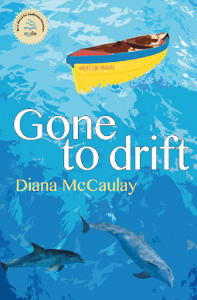 Series: Mutants, #3
Series: Mutants, #3
First Published: 12th April, 2016
Genre: Young Adult Science Fiction / Novel
Available: Amazon.com | Amazon UK
Piper is a dolphin-human hybrid, called a dolph. She and her friends are on the run from the scientist who created the dolphs. Her friends include her human boyfriend Tyler, her baby daughter Angel, dolph siblings Joel and Amy, and her human grandfather. Angel was recently created in a lab, from Piper and Joel’s DNA, and seems to have many new abilities. They’ll have to deal with strange storms, voodoo, and love triangles. Note that though it’s generally a light book, there are some scenes of medical torture.
I like stories centred around oceans and mermaids, so I thought I’d give this one a try. Dolphin-human hybrids sounded as though they could be interesting, even with a mention of a love triangle (which isn’t my thing) and voodoo (often handled very badly) in the description. Sometimes I regret my choices.
It’s told from the alternating perspectives of Piper and Joel. The book is not well-written right from the start. It has confusing and awkward lines, dialogue that doesn’t sound real, and paper-thin characters. The opening makes little sense, as it has Joel waking up from having his tracking chip removed. But no one considered that taking off the suppressor he was wearing would lead the bad guys right to them. There’s no obvious reason why the suppressor couldn’t be kept near the chip at all times during surgery, except that the plot couldn’t happen if they were sensible.
So Piper, Joel and Angel need to get back to the others immediately, as the bad guys might be on the way. That means time to stop for a swim, which mainly seems to happen so Joel can admire Piper’s long legs, flat belly and perky breasts. That’s obviously more important than getting to safety.
Piper doesn’t get to make her own decisions about the love triangle (with Tyler and Joel). It’s all about what the men decide to do, not about what she decides. They decide if it’d be wrong for her to have a relationship with them. They decide when it’s over. Piper is often likened in the narrative to her daughter. They do the same things, get the same gifts from Joel, and he thinks of them together as his girls… but Piper is an adult and Angel is a child. Everyone seems to forget that Piper is not a child, and should be able to make her own decisions.
At one point, Piper does complain that a decision was made for her. But the narrative is quick to confirm she’s just being silly, as Joel knows best and is doing what’s right. Later, Piper thinks of herself as being female and irrational. Thank goodness she has some rational men around to guide her and save her from danger.
Angel is the perfect child. She doesn’t smell like vomit, never needs her nappies changed, and is always cooperative. She is the best dolph of them all, as she can speak as a baby, swim faster, is telepathic, and knows the languages of all living creatures. I was waiting for some crack, but she remains perfect in every way. I suppose she had to be, because it’s not like her parents were about to come up with a plan before rushing into certain death.
This is science fiction that doesn’t realise it’s not hard science, so keeps trying to explain things in ways that break the suspension of disbelief. More handwaving the details would have gone a long way, because the science is magic.
For example, having DNA from a certain species wouldn’t magically give someone the abilities of that species. Only having the traits the DNA codes for would do that. But in this book, dolphin DNA means they can swim faster, without any fins, flippers, webbed hands/feet or anything of that nature. When Angel can swim even faster, they think she must have some fish DNA that causes that. But still no outward physical swimming adaptations.
What dolphin DNA does give them is a blowhole and the ability to hold their breath for a long time. It also gives them eyes the colour of the ocean, hot model bodies, wonderful body scent, and beautiful voices. Because dolphins are known for all those things.
There’s also the discussion about dolphin telepathy. Saying that dolphins are telepathic, and therefore that’s why Angel is telepathic, is the sort of handwaving that goes on in science fiction. However, it actually says, “Dolphins can encode information with their echolocation and whistles. Some folks consider that telepathic.” I encode information in sounds from my vocal chords all the time, which I like to call having a language.
On to the part I was concerned about from the initial description: the voodoo. Molita is a vodou high priestess, who does various rituals for them. Angel, of course, is wiser than anyone who practises vodou and teaches Moilta better ways to do things. Later, there’s a conversation between the characters to explain to the reader about vodou. The whole thing is awkward, and full of the white characters thinking of it as dangerous dark magic and the like. There is at least some pushback that it’s a religion, but I wouldn’t call this a good example of vodou. It’s about on a level with the rest of the book.
Amy is barely there as a character, until she needs rescuing. One of the bad guys is described as albino, which reinforces the trope of albinistic people being inherently evil. Everyone falls in instalove. There are just so many points where I regretted thinking dolphin-human hybrids sounded fun.
Bad writing, worldbuilding and characterisation mean there’s not a lot going for this. I can see people reading it to boggle at the badness, but there’s not a lot else to recommend it. I did like the pet chicken.
[A copy of this book was received from the publisher for review purposes]
 First Published: 29th March, 2016
First Published: 29th March, 2016 Series: A Folley & Mallory Adventure, #3
Series: A Folley & Mallory Adventure, #3 First Published: 1st September, 2011
First Published: 1st September, 2011 First Published: 28th February, 2016
First Published: 28th February, 2016